Evaluation of halide encapsulation in a cuboctahedron Cu12 cage. Structural and interaction energy in a highly coordinated cavity in the [{TpMo(μ3-S)4Cu3}4(μ12-X)]− (X = Cl−, Br−, I−) species
IF 3.1
3区 化学
Q3 CHEMISTRY, PHYSICAL
引用次数: 0
Abstract
Anion encapsulation is an attractive research field in supramolecular chemistry, given the crucial role of anion recognition in several issues. Here, we evaluate the nature of the anion encapsulation provided by the highly coordinating Cu12-cuboctahedron cavity characterized in the [{TpMo(μ3-S)4Cu3}4(μ12-I)]− (1I) cluster. From calculations, the series of Cl-, Br-, and I- encapsulating species were evaluated, highlighting the flexibility of the metallic cage to maximize the interaction with a main electrostatic interaction character complemented with a sizable charge transfer. Thus, using inorganic cages featuring multiple binding sites offers a versatile template for further artificial receptors for anions and other species.

立方体Cu12笼中卤化物包封的评价。[{TpMo(μ3-S)4Cu3}4(μ12-X)]−(X = Cl−,Br−,I−)中高度配位腔的结构和相互作用能
阴离子包封是超分子化学中一个很有吸引力的研究领域,阴离子识别在一些问题中起着至关重要的作用。本文对[{TpMo(μ3-S)4Cu3}4(μ12-I)]−(1I)簇中cu12 -立方面体高配位腔的阴离子封装性质进行了评价。通过计算,对Cl-、Br-和I-包封物质进行了评估,强调了金属笼的灵活性,以最大限度地发挥静电相互作用特征,并辅以相当大的电荷转移。因此,使用具有多个结合位点的无机笼为阴离子和其他物种的人工受体提供了一个通用的模板。
本文章由计算机程序翻译,如有差异,请以英文原文为准。
求助全文
约1分钟内获得全文
求助全文
来源期刊

Chemical Physics Letters
化学-物理:原子、分子和化学物理
CiteScore
5.70
自引率
3.60%
发文量
798
审稿时长
33 days
期刊介绍:
Chemical Physics Letters has an open access mirror journal, Chemical Physics Letters: X, sharing the same aims and scope, editorial team, submission system and rigorous peer review.
Chemical Physics Letters publishes brief reports on molecules, interfaces, condensed phases, nanomaterials and nanostructures, polymers, biomolecular systems, and energy conversion and storage.
Criteria for publication are quality, urgency and impact. Further, experimental results reported in the journal have direct relevance for theory, and theoretical developments or non-routine computations relate directly to experiment. Manuscripts must satisfy these criteria and should not be minor extensions of previous work.
 求助内容:
求助内容: 应助结果提醒方式:
应助结果提醒方式:


